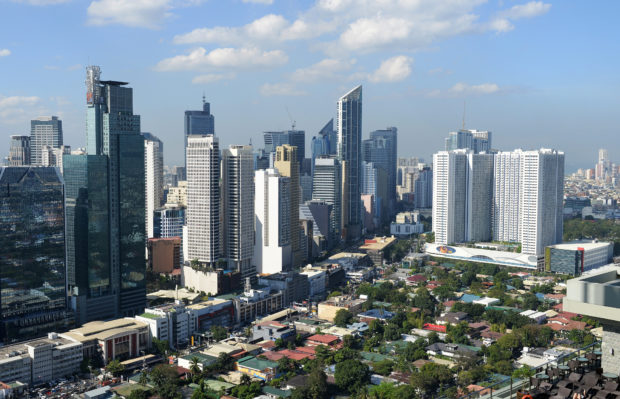
This photo taken on January 29, 2019 shows a general view of the skyline of the financial district of Makati in Manila. (Photo by Ted ALJIBE / AFP)
MANILA, Philippines—It’s mostly external challenges that posed near-term risks to the Philippines’ financial system, but an interagency body on Monday (June 6) unveiled a framework to ultimately protect Filipinos longer.
Launched by the Bangko Sentral ng Pilipinas (BSP) on Monday the Financial Stability Coordination Council’s (FSCC) systemic risk crisis management (SRCM) framework was “in keeping with the objective of managing systemic risks and strengthening the resilience of the system,” BSP Governor Benjamin Diokno said in a speech.
The FSCC groups the BSP, the Department of Finance (DOF), the Insurance Commission (IC), the Philippine Deposit and Insurance Corp. (PDIC), as well as the Securities and Exchange Commission (SEC).
“It defines arrangements among the FSCC agencies that we will rely on in good times so that we are best organized under stressed conditions,” Diokno said.
“The SRCM is a strategic document that highlights how our ongoing tasks contribute to crisis management and identifying initiatives which we believe are needed moving forward. As we develop the tactical plans that underpin this strategic document, the SRCM is thus a living document that evolves with the market and the needs of its stakeholders,” Diokno said.
Diokno pointed out that economic crises like the Asian financial crisis of 1997-1998, the global financial crisis of 2008-2009, and COVID pandemic-induced global recession in 2020, among others, were “unexpected but create significant disruptions as they unfold.”
“Someone will always bear the costs of the least disruptions, and invariably it is the public,” Diokno noted.
In a separate interview with ANC, Diokno said the SRCM was done to monitor risks during good times so that the domestic economy will be prepared during “stress” times. “We look at all the possible risks, not only on the part of the public sector, but also on the part of the private sector.”
Diokno said that at present, he didn’t see any domestic-caused risks to the financial system as most challenges come externally, such as slowing global growth, higher oil prices wrought by Russia’s prolonged invasion of Ukraine, as well as the US Federal Reserve’s normalization or aggressive interest rate hikes on the horizon.
“But other than that, we don’t see any risk for the Philippine economy,” Diokno said.